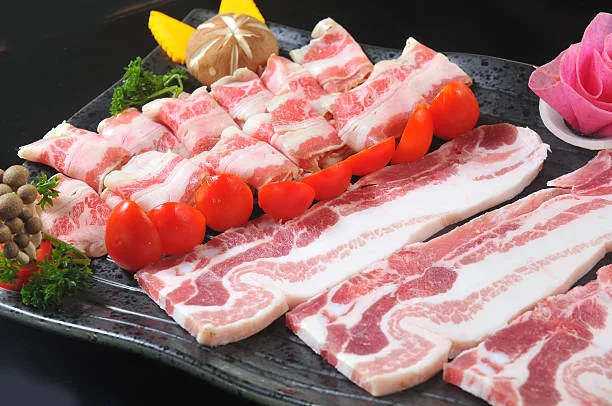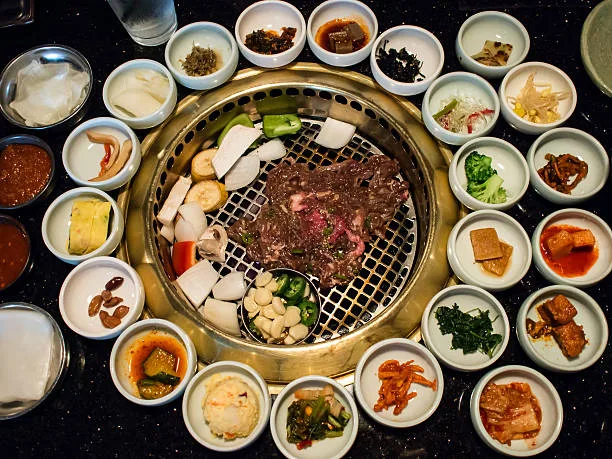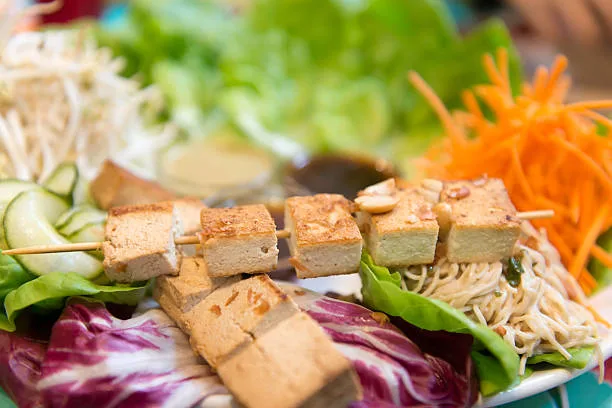1. The Best of Korean BBQ: From Galbi to Bulgogi
Korean BBQ is a popular style of cooking meat, often beef, pork, or chicken, that originated in Korea. The meat is typically marinated in a flavorful sauce, then grilled at the table on a gas or charcoal grill, or sometimes on a stove-top grill. Korean BBQ is often served with various side dishes, such as kimchi, pickled vegetables, and rice.
One of the most popular Korean BBQ dishes is bulgogi, which is thinly sliced beef that has been marinated in a mixture of soy sauce, sugar, sesame oil, garlic, and other seasonings. Another popular dish is galbi, which is beef short ribs that have been marinated in a similar mixture.
Table of Contents
Korean BBQ restaurants often offer an all-you-can-eat option, where customers can grill as much meat as they like for a set price. Many Korean BBQ restaurants also offer a range of other Korean dishes, such as bibimbap, a rice bowl topped with vegetables, meat, and sometimes a fried egg, and japchae, a dish made with sweet potato noodles, vegetables, and sometimes meat or seafood.
More on World of Korean Street Food and Snacks
Types of Meats for Korean BBQ
Korean BBQ typically uses a variety of meats, including beef, pork, chicken, and sometimes seafood. Here are some of the most popular types of meat used in Korean BBQ:

- Beef: Thinly sliced beef is one of the most popular meats used in Korean BBQ. The most commonly used cuts of beef are sirloin, ribeye, and brisket. Bulgogi, which is marinated beef, is a popular Korean BBQ dish made with thin slices of beef.
- Pork: Pork is another popular meat used in Korean BBQ. Pork belly, which is the same cut of meat used to make bacon, is a popular choice for Korean BBQ. It is often sliced thinly and grilled until crispy. Pork shoulder is another cut of pork that is commonly used in Korean BBQ.
- Chicken: Chicken is also a popular meat used in Korean BBQ. Chicken thighs are often used because they are more flavorful and juicy than chicken breasts. Dakgalbi, which is spicy marinated chicken, is a popular Korean BBQ dish made with chicken.
- Seafood: While not as common as beef, pork, or chicken, seafood is sometimes used in Korean BBQ. Squid, shrimp, and scallops are some of the seafood options that can be grilled on a Korean BBQ grill.
Overall, Korean BBQ offers a wide variety of meats to choose from, all of which can be marinated in flavorful sauces and grilled to perfection at the table.
Grilling process of Korean BBQ
The grilling process of Korean BBQ typically involves a gas or charcoal grill, or a stove-top grill, which is set up at the center of the table. The grill is often surrounded by a variety of side dishes, such as kimchi, pickled vegetables, and rice.

Here’s a general overview of the grilling process for Korean BBQ:
- Heat up the grill: If using a gas or charcoal grill, heat it up until it reaches the desired temperature. If using a stove-top grill, heat it up over medium-high heat.
- Prepare the meat: Thinly slice the meat and marinate it in a flavorful sauce for at least 30 minutes. Some Korean BBQ restaurants may marinate the meat beforehand, so it’s ready to grill when it arrives at the table.
- Grill the meat: Place the marinated meat on the grill and cook it until it’s cooked through, flipping it occasionally. The cooking time will depend on the thickness of the meat and the desired level of doneness.
- Serve and enjoy: Once the meat is cooked, remove it from the grill and serve it with the side dishes. You can wrap the meat in lettuce leaves, add some rice and sauce, and eat it like a wrap.
Throughout the grilling process, it’s important to keep an eye on the meat to ensure it’s cooked to your liking and doesn’t burn. Some Korean BBQ restaurants may provide grilling tools and tongs to help you cook the meat. Enjoy!
What are some common side dishes served with Korean BBQ?
Korean BBQ is often served with a variety of side dishes, known as banchan, which are meant to complement the grilled meat and add different flavors and textures to the meal.

- Kimchi: This is a spicy and sour fermented vegetable dish that is a staple in Korean cuisine. It’s often made with cabbage, radish, or cucumber and can be eaten on its own or used as a condiment.
- Pickled vegetables: In addition to kimchi, Korean BBQ often includes a variety of pickled vegetables, such as pickled radishes, pickled cucumbers, and pickled garlic.
- Steamed rice: Rice is a staple in Korean cuisine and is often served with Korean BBQ. It’s typically steamed and served in a bowl.
- Japchae: This is a Korean noodle dish made with sweet potato noodles, vegetables, and sometimes meat or seafood. It’s often served as a side dish at Korean BBQ restaurants.
- Pajeon: This is a Korean pancake made with scallions and sometimes seafood. It’s often served as an appetizer or side dish at Korean BBQ restaurants.
- Bean sprout salad: This is a refreshing salad made with blanched bean sprouts, sesame oil, and soy sauce.
- Spinach side dish: This is a simple side dish made with blanched spinach, sesame oil, and soy sauce.
These are just a few examples of the many side dishes that may be served with Korean BBQ. The variety and selection of banchan may vary depending on the restaurant.
What are some common drinks that are served with Korean BBQ?
Korean BBQ is often served with a variety of drinks, both alcoholic and non-alcoholic, that are meant to complement the flavors of the grilled meat and banchan.

- Soju: This is a clear and colorless distilled alcoholic beverage that is often referred to as the national drink of Korea. It has a slightly sweet taste and is typically served in small shot glasses.
- Makgeolli: This is a traditional Korean rice wine that is made by fermenting rice, wheat, or barley. It has a milky white appearance and a slightly sweet taste.
- Beer: Beer is a popular alcoholic beverage to pair with Korean BBQ. Many Korean BBQ restaurants offer a variety of domestic and imported beers.
- Green tea: Green tea is a common non-alcoholic beverage that is served with Korean BBQ. It’s often used to cleanse the palate between bites of grilled meat.
- Korean soft drinks: There are several Korean soft drinks that are popular at Korean BBQ restaurants, such as Sikhye, which is a sweet rice punch, and Chilsung Cider, which is a carbonated lemon-lime soda.
- Soju-based cocktails: Some Korean BBQ restaurants offer soju-based cocktails, such as soju mojitos or soju margaritas, which are a refreshing and fruity option to pair with grilled meat.
These are just a few examples of the many drinks that may be served with Korean BBQ. The selection may vary depending on the restaurant.
The Social Aspect of the Korean BBQ Gathering
Korean BBQ is more than just a meal – it’s a social event that is meant to be enjoyed with friends and family. In Korean culture, food is often seen as a way to bring people together and strengthen relationships, and Korean BBQ is no exception.

- Shared experience: Korean BBQ is typically grilled and served at the center of the table, where everyone can gather around and cook the meat together. This creates a shared experience where everyone can participate in the cooking process and enjoy the meal together.
- Group dining: Korean BBQ is often served family-style, with large platters of meat and banchan that are meant to be shared among the group. This encourages conversation and interaction between diners.
- Casual atmosphere: Korean BBQ restaurants often have a casual and relaxed atmosphere, which encourages people to stay and socialize after the meal. Many Korean BBQ restaurants also offer private dining rooms, which can be reserved for groups and provide a more intimate setting for socializing.
- Celebratory occasions: Korean BBQ gatherings are often associated with celebratory occasions, such as birthdays, anniversaries, and other milestones. This reinforces the social aspect of Korean BBQ and makes it a special event that people look forward to.
What are some recommended Korean BBQ dishes?
Korean BBQ offers a wide variety of dishes, so there’s something for everyone. Here are some recommended Korean BBQ dishes that you may want to try:

- Bulgogi: This is a classic Korean BBQ dish made with thin slices of marinated beef. The marinade typically includes soy sauce, sugar, sesame oil, garlic, and other seasonings. Bulgogi is often served with lettuce leaves and rice.
- Galbi: This is another popular Korean BBQ dish made with beef short ribs that have been marinated in a sweet and savory soy sauce mixture. Galbi is often served with lettuce leaves and rice.
- Samgyeopsal: This is a popular Korean BBQ dish made with thick slices of pork belly that are grilled until crispy. Samgyeopsal is often served with lettuce leaves, sliced garlic, and a dipping sauce made with sesame oil, salt, and pepper.
- Dakgalbi: This is a spicy Korean BBQ dish made with marinated chicken, vegetables, and spicy gochujang sauce. It’s often cooked on a skillet at the table and served with rice cakes and cheese.
- Jumulleok: This is a Korean BBQ dish made with marinated beef or pork skewers that are grilled until crispy. Jumulleok is often served with a dipping sauce made with soy sauce, sesame oil, garlic, and green onions.
- Seafood: Korean BBQ also offers a variety of seafood options, such as shrimp, squid, and scallops, that can be grilled and served with banchan.
These are just a few examples of the many delicious Korean BBQ dishes available. Be sure to explore the menu and try different dishes to find your favorites!
What are some vegetarian options for Korean BBQ?
While Korean BBQ is typically known for its meat dishes, there are also some vegetarian options available. Here are some vegetarian options for Korean BBQ:

- Vegetable skewers: You can grill various vegetables on skewers, such as mushrooms, bell peppers, onions, and zucchini. These can be brushed with a flavorful marinade or simply grilled with salt and pepper.
- Tofu: Grilled tofu can be a great vegetarian option for Korean BBQ. You can marinate it in a soy sauce-based marinade or simply grill it with salt and pepper.
- Kimchi pancakes: Kimchi pancakes, or kimchijeon, are savory pancakes made with kimchi batter and various vegetables. They are often served as a side dish at Korean BBQ restaurants.
- Japchae: Japchae is a Korean noodle dish made with sweet potato noodles, vegetables, and sometimes eggs. It’s often served as a side dish at Korean BBQ restaurants and can be made without meat.
- Grilled corn: Grilled corn on the cob can be a tasty and simple vegetarian option for Korean BBQ. You can brush it with butter and sprinkle it with salt and pepper for extra flavor.
- Banchan: Many of the side dishes served with Korean BBQ, such as kimchi, pickled vegetables, and bean sprout salad, are vegetarian-friendly and can be enjoyed as a main dish or side dish.
Some popular Korean BBQ restaurants in different parts of the world:

- Kang Ho Dong Baekjeong (USA): This restaurant chain has locations in several cities across the United States, including New York, Los Angeles, and Atlanta. It’s known for its high-quality meat and casual atmosphere.
- Maple Tree House (South Korea): This restaurant chain has several locations in South Korea and is known for its premium cuts of beef and extensive banchan selection.
- Gyu-Kaku (Japan): This popular Japanese chain has locations in several countries, including the United States, Canada, and Australia. It offers a variety of meats and vegetables for grilling, as well as a range of Japanese and Korean-inspired dishes.
- Ssikkek BBQ (Singapore): This Korean BBQ restaurant chain has several locations in Singapore and is known for its all-you-can-eat buffet-style dining. It offers a variety of meats and banchan, as well as a range of Korean and Asian-inspired dishes.
- Oiso Korean Traditional Cuisine & Cafe (Philippines): This restaurant in Manila, Philippines is known for its authentic Korean cuisine, including Korean BBQ. It offers a range of meats and banchan, as well as traditional Korean dishes like kimchi jjigae and bibimbap.


[…] like kimchi, bulgogi, and bibimbap, as well as popular street foods like tteokbokki and kimbap. Korean barbecue, where diners grill meat at the table, is a popular social dining experience. Street foods like […]